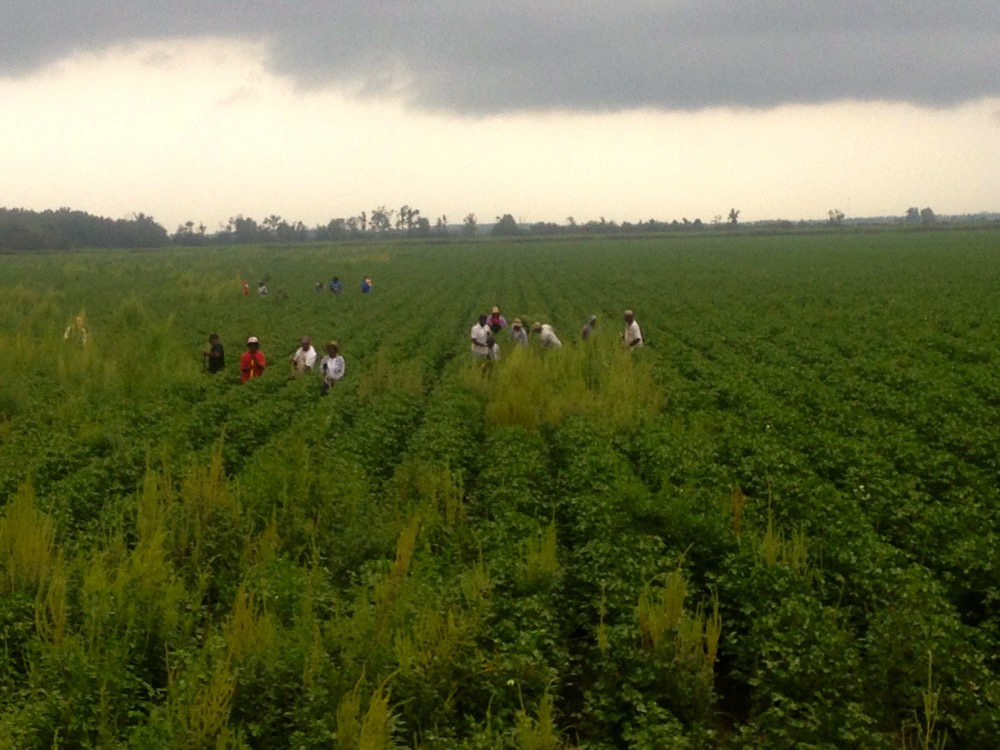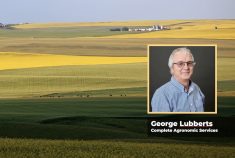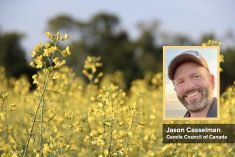In Australia, the problem is so bad growers are catching chaff with mechanical seed destructors or burning it in windrows in order to destroy weed seeds.
In the U.S. Cotton Belt, the unthinkable has happened and crews walk through fields, hand-roguing Palmer amaranth at $150 per acre.
In Europe, they’re resorting to more and more expensive weed-suppression cocktails, often running over $100 extra per acre.
These are the effects of herbicide-resistant weeds if they’re left unchecked for too long.
In Canada, most farmers have heard of the problem, but few are focusing on it in a big way, outside of the weed science professionals. Those folks are certainly making the case for action, but what’s less clear is how much attention anyone is paying to them. If we’re not, that’s a terrible irony, because right now is precisely when we should be listening, according to one weed control specialist.
Read Also

Agronomists share tips for evaluating new crop products and tech: Pt. 3
With new products, new production practices and new technology converging on the agriculture industry at a frenetic pace in recent…
Kate Sanford Mitchell manages the herbicide and insecticide portfolio for oilseed crops for Bayer CropScience in Calgary. The company takes the issue very seriously and has leveraged its global footprint to best understand the issue — including talking often with weed science specialists in other countries.
“It doesn’t matter where they’re from, they all say basically the same thing: ‘I wish we had been in the position Canada is in, where you know how bad it can get, and how quickly, but it’s not a big problem yet,’” she says.
That’s because dealing with the problem in its infancy is always going to be cheaper and easier, since the necessary steps will be less dramatic, problematic and expensive. If we miss this window, it’s likely that everyone in the business will look back and regret it.
To understand why getting this right is crucial, we need to understand what happens when weed resistance crops up in fields.
Herbicides not the cause
There’s often a perception herbicides cause resistance, but that’s not the case — what they actually do is reveal it. Clark Brenzil, a weed control specialist with the Saskatchewan agriculture ministry, tells Country Guide that weed populations are by their nature genetically diverse, and within every population are likely a few weeds resistant to any given chemistry.
Every time you spray, you’re applying selection pressure to that population. Then, if you spray often enough with the same chemistry, over time the population of non-resistant weeds will be wiped out, only to have the resistant weeds fill the “space” that’s been left. It is, simply put, just another day at the office for Mother Nature.
“To Mother Nature, we’re just another evolutionary challenge,” Brenzil says. “Nature is very diverse, resilient and resourceful and this is how it deals with this kind of challenge.”
That challenge has been around a while now too, with crop protection products coming along in the post-war years and enjoying a decades-long golden age. It seemed like a solution had finally been found for weeds, the most pernicious pest for field crops.
It’s small wonder that growers adopted the new technology so enthusiastically, and few had concerns about what might happen in the long term.
Started with atrazine
The 1970s saw the first problems begin to crop up with atrazine in corn. U.S. growers had been using it widely since its introduction in the mid-1950s, but suddenly, after many seasons of success, it was proving ineffective.
“That was our first clue as to what was happening,” Brenzil says.
Reaction was predictable — growers and industry simply moved on to the next-best alternative, since there were plenty of options. But after a few seasons, something troubling happened — resistance to the alternative.
“Now we had plants that were resistant to both chemicals,” Brenzil says.
That brought the concept of rotating chemicals by mode of action to the forefront. Because different modes of action attack weeds differently, it tilts the odds in favour of the farmer by making nature’s challenge just that much greater. It bought time, but the problem returned after just a few seasons, as more and more acres became infested with weeds, with some resistant to multiple chemistries.
The next strategy was to move on to tank mixes that apply multiple modes of action simultaneously. Think of this strategy as lining up a number of slot machines at a casino that all spin with a single pull of the handle. Developing resistance requires hitting a winner on all the machines in play at once, and with each additional chemistry, the odds against Mother Nature increase exponentially.
That strategy is close to the state of the art today, but even it’s still under refinement. The latest twist is applying a soil residual in the spring to reduce the weed population initially before in-season applications. A lower population means less selection pressure in this game of big numbers.
“That’s pretty much where we’re at today with chemistry,” Brenzil says.

Adding diversity
Adding more non-chemical control methods to the farm arsenal will be critical, says Bayer CropScience’s Sanford Mitchell. Since there’s nothing just around the corner to replace the chemical tools we do have, protecting them is crucial.
“There is nothing new on the horizon,” she says. “I wish I could say differently, but that’s the truth, and we’re all looking very hard. Even if we did find something tomorrow, it would still take 15 years and $250 million to develop it and bring it to market. Just for reference, it only took 10 years to get to the moon.”
While at least some of that delay is regulatory, it does underline the scale of the challenge facing the industry, and the necessity to have a plan to prevent a weed control disaster — something Sanford Mitchell’s international colleagues repeatedly state Canada has an opportunity to do.
Brenzil says, doing so is going to require adding diversity at almost every turn in order to keep Mother Nature off balance and not sure what to expect next.
That could include just about anything — cropping choices, seeding dates, seeding rates, even adding a bit of spring tillage when necessary.
“That’s not suggesting going back and undoing all the good things zero till has accomplished,” Sanford Mitchell stresses. “We’re talking about a bit of judicious tillage in spots you know are particularly bad.”
Nature notices routines
Brenzil adds that diversity can come in surprising ways, so in order to identify opportunities it’s necessary to look at your operation and identify patterns anywhere you can find them. To nature, a pattern is something predictable, like the pattern most growers use to seed in the spring.
“Almost everyone starts near the house, seeding those fields first, and works outward to the fields furthest away, seeding those last,” Brenzil says. “Why not start at the furthest field and work your way back toward the house?”
It might seem like a small thing, but a small thing, repeated season after season, has a selection effect on the weed population. Suddenly throw something different at them, and those populations need to adapt. That takes energy and time, giving your crop the opportunity to get up and growing before the weeds take hold and set more seed.
“We’re going to be looking at incorporating a lot of small changes,” Brenzil says. “There will be no silver bullet.”
Sanford Mitchell says even modest changes have been proven to have a big effect. A U.S. study, for example, looked at the direction farmers sowed their fields. Researchers sowed wheat in a north-south direction and in an east-west direction. Planting east-west oriented the crop to block sunlight to the weeds more effectively, preventing them from competing with the crop.
“It decreased weed density by 51 per cent and increased yield by 24 per cent, just by changing the direction of seeding,” she says. “How simple is that?”
Think local
The relatively simplicity — and importance — of taking those first steps is something she hopes growers are coming to understand as the challenge grows. If she’s concerned about anything it’s that too often farmers are paralyzed by the scope of the problem, and feel that there’s nothing they can do.
“It is a global problem, but with a local solution,” she says. “It starts with one field, and it starts today. Every farmer has a field that they know is a bit bad — that’s where they should start.”
It also doesn’t matter what your neighbours do — or don’t do. Many farmers have the perception that unless everyone around them takes the same steps, any effort is futile — but that’s never been the case. Consider the number of weedy fields that have, over the years, existed side by side with clean ones, and the case for individual action becomes clear.
“There are farmers out there who are farming in areas where resistance has become a real problem, yet it’s not really on their farm,” she says.
Crowdsourcing
Crop protection companies like Bayer CropScience have a growing interest in keeping this situation under control, even to the point of doing things that would have been unthinkable just a few years ago — like telling a producer that it might be time to switch away from their products to a different family of chemicals, including options that might be made by their competitors.
Sanford Mitchell concedes it’s a sea change for companies long used to fighting for every last acre for their products, but says it highlights the growing realization in the business that it’s not just farmers that have to make some sacrifices for the overall sustainability of these crop protection tools.
“I think we’ve come to recognize that it’s not just up to farmers — we need to be sustainable too,” she says.
One effort Bayer CropScience is making to add to the conversation can be found online at mixitup.ca. It’s a low-key and unbranded website where you’ll find the only mention of the company itself in the fine print at the bottom — this is clearly a site that’s all about the issue.
“It’s a place for us all to share our ideas and experiences with resistant weeds, and find solutions,” Sanford Mitchell says.
It’s a practical application of a high tech concept built for the Information Age, but in the end really boiling down to the old axiom of having many minds seeking a solution. By sharing information and sparking the discussion, hopefully a solution will become just that much nearer.
They key will be to not ignore the problem and hope it goes away — because it won’t. Without action it will just get worse, season after season.
What remains unclear is if the sector will rise to the challenge. If it does, it could become a key competitive advantage, while others grapple with higher cost of production.
If it doesn’t, this will be just another missed opportunity, and those international experts will shake their heads and wonder how it could happen, with all that warning.
This article was originally published as, “Now or never,” in the February 16, 2016 issue of Country Guide
















